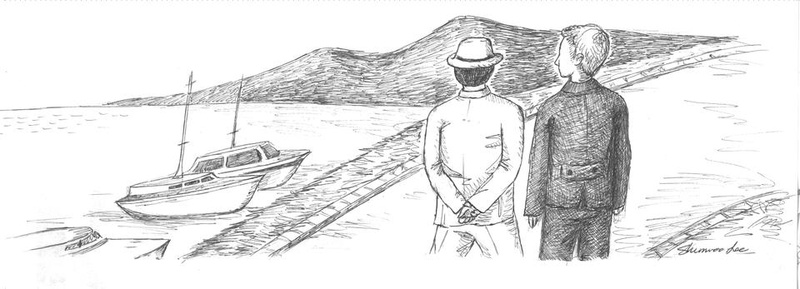In an article about Argentina’s bicentennial, n+1 founder and editor Benjamin Kunkel commented that in that country, “crisis has enforced creativity.” Holding up the nation’s artistic triumphs as a positive outcome of its tragic history is problematic, to say the least. And yet it’s hard to argue with the growing body of evidence for Kunkel’s claim, to which Juan José Saer’s most recently translated novel, “The Sixty-Five Years of Washington,” rendered in English by Steve Dolph, is a formidable addition. Despite frequent patches of unwieldiness, the book’s nuanced exploration of trauma, consciousness, and memory is nevertheless engaging; through Saer’s demanding style, a stark, elegiac beauty often shines.
“The Sixty-Five Years of Washington” follows two acquaintances, Angel Leto and the unnamed Mathematician, who stroll through the seaside town of Santa Fe on an October morning in 1961. Saer often digresses, detailing incidents in the two men’s lives before and after their walk together, but always returns to a birthday party that the two men missed over the weekend, held for the militant-turned-academic Washington Noriega.
It should be clear that Saer’s politics are not particularly subtle. Washington Noriega, whose name is a composite of two symbols of U.S. intervention in Latin America, is omnipotent and omnipresent but oddly passive throughout the novel. His influence casts a heavy layer of ennui that penetrates beyond the characters’ disappointment at having missed the party. If this sounds heavy-handed, it is. For some U.S. readers, the psychological complexity of Saer’s narrative might belie its simplistic politics—the characters live in fear of “the government,” carry suicide pills, and fawn over Noriega, whose ludicrous back story only makes sense as an allegory.
Saer is all too willing to include polemical non sequitur—as the men pass a church on their walk, he can’t resist adding “that some religions, as if the presence of a creator were not evident in the creation itself, need to make use, to demonstrate his existence, of some sign of his existence that’s separate from the objects he created.” This didacticism recalls Orwell and Huxley, and may seem outmoded to those accustomed to the political ambivalence of contemporary American fiction. It is only in the context of Argentina’s tragic twentieth century, which saw authoritarianism, torture, and assassinations continue well into the late 1970s, that Saer’s angry politics begin to make sense.
Saer is more successful in his rendering of Leto’s and the Mathematician’s interior states. Although the men are ostensibly in conversation with each other for the entire novel, each is preoccupied with his own thoughts, which Saer presents with painstaking attention to psychological consistency and detail. It is established early on that the Mathematician “swim[s] in the colorless river of premises, of propositions, of postulates,” but his emotional detachment and stubborn rationalism are only revealed gradually. When, at the end of the book, he earnestly tries to formulate an equation to describe his feeling of separation from his surroundings, the effect is dramatic but not overwhelming, because Saer has applied the Mathematician’s layers of alienation so carefully. Leto’s actions at the end of the novel are drastic in a different way, but Saer prepares the character just as carefully.
Yet the great strength of “The Sixty-Five Years of Washington” does not lie in its politics or its people. Rather, it can be found in Saer’s portrayal of the inadequacy of memory, and the flaws in human perception of reality. He is deeply interested in how memories are created and recalled, and is careful to record everything that lingers in the character’s minds as well as everything that they forget. Leto, the Mathematician, and their friends all construct false memories, and forget incidents that are true and important. Saer’s shimmering mirage of reality disorients and frustrates, always at the service of the larger tragedy of human fallibility.
Unfortunately, this style is inconsistently effective. Saer’s sentences wind on and on, doubling back, interjecting, correcting themselves. The effect is the same rewarding headache that Faulkner’s novels have been known to induce, but it should be noted that the rewards offered by “The Sixty-Five Years of Washington” are fewer and further between. Saer’s ramblings have none of the economy of Faulker’s prose. “They are going nowhere, in fact,” Saer observes of Leto and the Mathematician, “and unburdened, you could say, of duties or destination, they walk inside an integral, palpable actuality that spreads through them and that they likewise disperse, a delicate and transient organization of the physical—delimiting and containing, during an unforeseen lapse, the dismaying and destructive blind drift of things.” The narrator’s voice has the immediacy of any good stream of consciousness, but unpacking the layers of subordinate clauses does not yield much beyond a vague sense of erudition. These stylistic convolutions exist only for their own sake, and given Saer’s impressive intellect and moral conviction, he might have invested his florid prose with more political urgency.
Given its lofty historical and ontological concerns, it is easy to forget that “The Sixty-Five Years of Washington” is ultimately a travel narrative: a morning’s journey of 21 blocks. Saer punctuates his characters’ musings with descriptions of Santa Fe, and he fixates on a conception of “the city not as though it were divided into neighborhoods or sections, but rather into territories in the animal sense, an archaic and violent demarcation of ritual, bloody defense.” Yet Saer seems more interested in the social fragmentation of national trauma than in its geographical repercussions. In his Argentina, people are isolated from each other, and they are lucky if their experiences overlap enough to chat about Washington Noriega’s birthday last weekend. That may be the case, but it’s fortunate that this latest translation affords one last chance to glimpse Saer’s distorted and provocative inner world.
—Staff writer Abigail B. Lind can be reached at alind@fas.harvard.edu.
Read more in Arts
Democracy Goes Green













